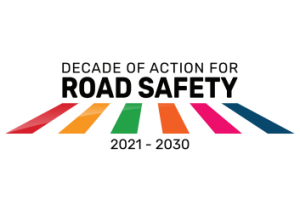The launch of the Decade of Action for Road Safety 2021-2030 sets the ambitious target of preventing at least 50% of road traffic deaths and injuries by 2030. To realize this vision, UNECE partnered with WHO and its sister UN Regional Commissions to develop a Global Plan for the Decade of Action, which is released today.
Globally, road traffic crashes cause over 1.3 million preventable deaths and an estimated 50 million injuries each year – making it the leading killer of children and young people worldwide aged 5-29. As things stand, they are set to cause a further estimated 13 million deaths and 500 million injuries during the next decade, particularly in low- and middle-income countries. These unacceptable numbers, both in absolute and relative terms. Road traffic crashes have remained a major cause of death globally, even though every one of those deaths and injuries is preventable.
UNECE Executive Secretary Olga Algayerova stated “We need a change of gear in political commitment and in focus, valuing safety at the heart of sustainable mobility to deliver on the 2030 Agenda. Grounded in a Safe System approach, the Global Plan for the Decade of Action will guide our collective efforts to leverage proven measures such as the UN road safety legal instruments. UNECE stands ready to assist countries through its legal and policy tools, and is proud to support the vital work of the UN Secretary-General’s Special Envoy for Road Safety and UN Road Safety Fund.”
The Special Envoy, Mr. Jean Todt, said “The Global Plan offers a framework of actions needed for countries and cities to reach our target to halve road deaths and injuries by 2030. The Plan gives credit to the linkages of road safety to other important development agendas such as climate mitigation, child health, sustainable cities, Covid-19 recovery and technology. These linkages help the world understand the true returns gained by investing in road safety. And here, the UN Road Safety Fund will be a critical tool to mobilize financing. As we start the new Decade, I call on all governments and their partners to do more to save lives on the world’s roads.”
Recognizing the importance of the problem and the need to act, governments from around the world declared unanimously – through UN General Assembly Resolution 74/299 – the Decade of Action for Road Safety 2021-2030 with the explicit target to reduce road traffic deaths and injuries by at least 50% during that period.
The new Global Plan describes the actions needed to achieve that target. This includes accelerated action to make walking, cycling and using public transport safe, as they are also healthier and greener modes of transport; to ensure safe roads, vehicles and behaviours; and to guarantee timely and effective emergency care. It highlights that proven implementation measures such as legal frameworks based on United Nations road safety legal instruments will be essential.
The Plan further stresses the need for accrued financing for road safety interventions. The UN Road Safety Fund will continue to strengthen governments’ capacity to effectively implement lasting road safety improvements by leveraging public and private investments towards high-impact initiatives in low-and middle-income countries, where over 90% of fatalities occur.
The Plan also underscores the role of the UN Secretary-General’s Special Envoy for Road Safety, who will continue to mobilize political commitment and raise awareness of the importance of prioritizing road safety, including through national plans and budgets, as well as promoting its links with other SDGs.
Leveraging proven tools: the UN road safety legal instruments
UNECE hosts the UN road safety legal instruments, which include eight key legal instruments under five categories: traffic rules, road signs, vehicle regulations, the transport of dangerous goods, and professional driver fatigue. Seven of these eight legal instruments are named in the latest General Assembly’s resolution on “Improving global road safety” A/74/299 of August 2020.
The General Assembly resolutions over the years have consistently encouraged member States to accede to all of the UN road safety legal instruments, and beyond accession, to implement and apply their provisions or safety regulations.
Recent accessions in 2021 include Estonia (1949 Convention on Road Traffic) and Ethiopia (1968 Convention on Road Traffic). This reflects the global nature of the UN road safety legal instruments.
Besides the UN road safety legal instruments, the UNECE Inland Transport Committee Recommendations on Enhancing National Road Safety Systems adopted in 2020 help countries to systematically develop their national road safety systems following the safe system approach.
The ITC’s subsidiary bodies which include the Global Forum for Road Traffic Safety and World Forum for the Harmonization of Vehicle Regulations, Working Party on Road Transport and Working Party on the Transport of Dangerous Goods, administer and keep the UN road safety instruments up to date. These working parties also play an active role in shaping global discussions and best practices related to road traffic rules, road signs and signals, safe vehicles, and the transport of dangerous goods.
